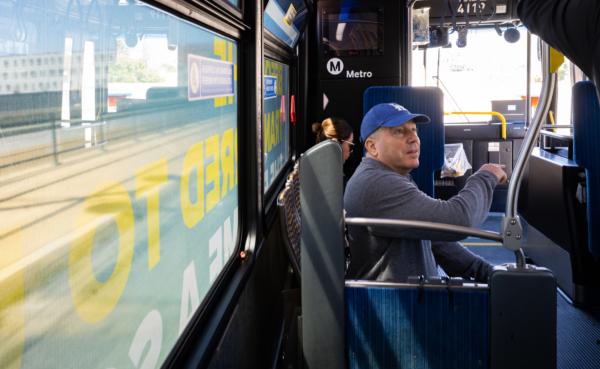LOS ANGELES—Following a spate of shockingly violent attacks on Metro buses and trains in recent weeks, the Los Angeles Metropolitan Transit Authority—better known as Metro—is expediting plans to retrofit its entire fleet of buses with shatter-proof glass compartments to protect drivers, while increasing other safety and surveillance measures.
John M. Ellis, general chairman of a union representing 5,000 Metro train and bus operators, said the April 25 approval came after “countless hurdles.”
“We have reached a critical milestone,” Mr. Ellis said in a statement. “It can’t happen fast enough.”

A bus awaits passengers in Los Angeles on March 20, 2023. (John Fredricks/The Epoch Times)
The board authorized about $5 million to have its 2,000 buses retrofitted with tempered-glass compartments by the end of December.
“You can hit it with a bat all day long, but they won’t be able to break through it,” Mr. Ellis said of their design, which will fully enclose drivers and be welded to the bus frame.
The union has been pushing the county to move forward with the retrofits as attacks on transit operators have increased. A study by research nonprofit the Urban Institute published last year found that nationwide assaults on transit workers tripled between 2008 and 2022, steadily climbing and then surging after the pandemic.
“I drove the bus for 35 years and I understand what our members are all up against daily. No one can begin to comprehend what an operator faces during these unpredictable times,” Mr. Ellis said.
But in Los Angeles, spilling over into the transit system is the city’s spiraling homelessness, drug addiction, and mental health crises.
Recent attacks across disparate corners of the county include a string of assaults on Metro bus operators, as well as the brutal April 22 slaying of a passenger—a 66-year-old grandmother aboard Metro’s Red Line.
“This attack was preventable,” Los Angeles Supervisor Kathryn Barger, who sits on Metro’s board, said in a statement, calling the murder a “terrible and painful reminder of the reality Metro riders are facing every day.”
During the board meeting, Ms. Barger said she was afraid to use the transit system she helps oversee.
“I will not ride our transit system by myself,” she said.
In a statement, Metro pointed to “the drug abuse epidemic and untreated mental illness crises” fueling such attacks.

Homeless individuals scatter across the Los Angeles Metro system in Los Angeles on April 19, 2023. (John Fredricks/The Epoch Times)
“The behavior on our system reflects the issues that are seen in the surrounding communities across LA County,” the agency said, calling on “county and city partners” to do more to address issues “that spill over into our system.”
During the meeting, Ms. Barger called for increased fare enforcement and law enforcement patrols, analyzing data on violent crime and reoffenders, and expanding mental health services.
A Grandmother on Her Way Home From the Graveyard Shift
The April 22 murder of a woman aboard Metro’s Red Line came at a time when tensions were already high following a series of violent incidents on buses the previous week.
But the sheer brutality of the unprovoked assault—and the fact that the victim was an older woman relying on the train for her commute—has escalated the debate over public safety.
Mirna Soza Arauz, a 66-year-old Nicaraguan immigrant, was stabbed in the throat on her way home from a fast-food restaurant, where she worked the graveyard shift as a security guard.
Police said the suspect, arrested shortly after fleeing, is a transient with a long criminal history, including a 2019 assault on a Metro passenger. In the past four months, Los Angeles County Sheriff’s Department records show that Elliot Tramel Nowden was arrested three times, including in February for assault at the same station.

Passengers walk in the Westlake/Macarthur Park train station in Los Angeles on March 20, 2023. (John Fredricks/The Epoch Times)
He assaulted Ms. Arauz with two kitchen knives before fleeing on foot, police said. She was transported to a hospital, where she was pronounced dead.
It is the second homicide on Metro’s system so far this year.
In another incident, on April 13 in Willowbrook—a neighborhood in South Los Angeles—a suspect attacked a bus driver with brass knuckles and stabbed him in the chest before fleeing.
In a video circulating on social media, the driver can be heard saying, “Sorry! Sorry! Sorry!” and then screaming “Help me!” over and over again as his assailant attacks him.
A good Samaritan delivered the victim to a hospital and he survived. Using security camera footage, police days later arrested a suspect with a long rap sheet, who was paroled in February, according to Los Angeles County Sheriff’s Department records.
Other recent attacks include the stabbing of an elderly man after an argument ensued between two bus passengers, and an incident in Santa Monica in which a suspect kicked in the door of an off-duty bus and assaulted the driver.
And about a month ago, a suspect with a BB gun hijacked a Metro bus and crashed it into a hotel in downtown Los Angeles.
But Crime Is Down, Right?
By some metrics, violent crimes appear to be trending downward on Los Angeles transit. But the picture is complicated, and 2024 is off to a bad start.
According to the Los Angeles Police Department’s Transit Division, which oversees enforcement of about 68 percent of Metro’s system, the most serious crimes—such as homicide, rape, larceny, and aggravated assault—are down by nearly 40 percent year to date from 2023.
The Los Angeles County Sheriff’s Department, which oversees a smaller portion of the system, also reported a slight decrease in the same crimes in 2023 from the previous year.
Metro’s data show that assaults on operators decreased by 8.2 percent in 2023 from 2022, per 1 million boardings.
Violent crime, illicit drug use, and deadly overdoses on trains and buses skyrocketed in 2022. A number of attacks and deaths were particularly gruesome: a man was set on fire, another was disemboweled in a knife fight, and a homeless man was killed sleeping on the tracks, according to the Sheriff’s Department.
Ridership continued to plummet in early 2023.
But in February, Metro announced that ridership had increased by about 11 percent from 2022 to 2023, citing improvements in safety, cleanliness, and customer service. The agency suggested its efforts to curtail drug use were working, with a 30 percent reduction of such reports in 2023.

The Los Angeles Metro line transit system in Los Angeles on April 19, 2023. (John Fredricks/The Epoch Times)

The Los Angeles Metro Line transit system in Los Angeles on April 19, 2023. (John Fredricks/The Epoch Times)
However, 2024 appears to be off to a bad start.
Batteries on operators in February were also up by 83 percent compared to the same month in 2023.
Crimes against society were up by 246.8 percent in February over the same month last year, while total crimes—against society, persons, and property—were up by 52.6 percent during the same period.
Comparing annually, from March 2023 to February 2024 over the year prior, the agency says crimes against persons increased by nearly 10 percent, while property crimes fell by nearly 11 percent.
Crimes against society, however, increased by 550 percent during the same time frame.
In that 12-month period, total system-wide crimes in all three categories saw an increase of 78 percent.
The Battle Over Public Safety
The battle over public safety at Metro has played out in increasingly contentious ways as activists and elected officials who support removing or replacing law enforcement from the system spar with those who argue for greater police presence.
Since 2020, activists have pushed Metro to move away from traditional policing and instead adopt “community-based” public safety.
The idea behind the push, according to activists is “Metro as a Sanctuary,” which urges the pursuit of equity and “an affirmative vision to uproot whiteness, anti-Black racism, and white supremacy within Metro,” by shifting away from policing.
A “care-based” vision of public safety on Metro, they say, would prioritize “basic human needs” with “bathrooms, shade, lighting, cultural programming and food,” as well as mental health and outreach services.
In October 2023, Metro opted to expand and make permanent a pilot program that introduced “ambassadors”—unarmed employees who ride the lines and offer navigation help, as well as emergency services such as CPR and the administration of Naloxone, to reverse opioid overdoses—as part of its move toward what it calls “community-based” public safety.
“Their whole idea about a multi-layered ecosystem of public safety, this ambassador program as part of public safety—they’re not,” former Los Angeles County Sheriff Alex Villanueva told The Epoch Times. “That’s just a falsehood that’s being forced down the throats of passengers who have no choice.”

Former Los Angeles Sheriff Alex Villanueva uses the Los Angeles Metro system in Los Angeles on April 19, 2023. (John Fredricks/The Epoch Times)
While ridership may be up—it’s still below 2019 levels—the system is still plagued by the same issues, and a post-pandemic rebound has been hamstrung by ongoing public safety concerns that put riders and drivers alike at risk.
Santa Monica Mayor Phil Brock said reports of increased ridership because of Metro public safety improvements should be “parsed for reality.”
“Commuters’ sense of safety decreased in the past three to four years, both on Metro light rail lines and on buses,” Mr. Brock told The Epoch Times.
The Expo light rail line, the second-busiest in Metro’s system, which terminates near the beach in downtown Santa Monica, has led to a dramatic surge in that city’s transient homeless population, Mr. Brock said.
“We estimate that we receive six homeless people almost every hour of the day. In addition to that, at the end of the night, we receive 50 to 75 from the last train,” he said. “That’s an extra 100 people or more a day wandering around our city. So we are in crisis in Santa Monica.”
He said homeless people riding the Metro and concerns regarding safety on the system are not doing anything to get people out of their cars.
“You have to provide a safe, convenient way for them to go. And the safety has been lacking,” he said. “You can see it now by attacks on bus drivers. You can see it by attacks on fellow patrons of the bus and train lines.”
In an effort to address the estimated 5,700 homeless people living on the trains or train platforms, when he was sheriff, Mr. Villanueva, in 2022, launched what he called Operation Safe Travel, which increased law enforcement and removed homeless individuals through “outreach and early intervention.”
Crime fell dramatically, he said, and “it was the presence of deputy sheriffs on train systems enforcing the law” that did it. But the program only lasted a matter of months.
He said that years ago, when the Sheriff’s Department was exclusively contracted to provide safety for Metro, it enforced fare evasion.
“The place was spotless and it worked,” he said.

Former Los Angeles Sheriff Alex Villanueva uses the Los Angeles Metro system in Los Angeles on April 19, 2023. (John Fredricks/The Epoch Times)
Today, the task is shared between the Sheriff’s Department and the Long Beach and Los Angeles police departments.
And the battle over who will get hundreds of millions of dollars to provide public safety for Metro is ongoing.
Metro’s board last year voted unanimously to approve a plan for an in-house police department for about $173 million annually and expects to review staff reports for its development this spring. Meanwhile, activists are pushing for Metro’s entire public safety budget to go to more unarmed ambassadors.
In an email to The Epoch Times, a spokesman said Metro will expand its public safety teams, which include security officers, law enforcement partners, and ambassadors, in the coming months and is requesting additional bus-riding staff in its fiscal 2024–25 budget.
Donald Graham, deputy chief of LAPD’s Transit Division, told The Epoch Times he is skeptical of the feasibility of an in-house force.
“They’re welcome to do it. But in these challenging times, I don’t see how they’re going to do it for the proposed costs—not to mention, where they think they’re going to recruit from,” he said. “If LAPD, the LA Sheriff’s Department, the CHP, the FBI, NYPD—police departments that have major names, huge legacies, fairly good salaries, and a plethora of career choices—are having problems hiring, I don’t see where that’s going to come from.”
At its April 25 meeting, Metro board members also called for increased security cameras, artificial intelligence facial recognition technology, weapons detection, and possible measures to ban “problematic individuals” from the system.
But even those who support increased law enforcement and surveillance suggest it’s not the whole picture.
“I don’t know what’s happened to this culture, but the idea of one person involved in an altercation with another person, and then 75 other people filming it instead of anyone calling for help—we’ve got to get past that if we want to see real change in society,” Mr. Graham said.
‘It’s Everywhere’
On a recent visit to the MacArthur Park Metro Station in Westlake, just outside of downtown Los Angeles, above ground was a carnival of open-air drug use, with dozens of people in various states of psychosis, many badly in need of medical attention, their limbs covered in open sores. Someone asked where the elevator was. Pointing to it, a woman yelled: “It’s filthy! But what do you expect? This is MacArthur Park.”
In the park across the street, dozens more lay sprawled under palm trees, or folded over on themselves. Many congregated in small groups, passing silver squares of foil.
A descent via stairs to the underground platforms is through a cloud of flies and the clinging stench of urine. Classical music plays through speakers, meant as a deterrent for loitering. The turnstiles are open, and no one checks for fares. Used needles dot the streams of trash between train tracks. And Metro “ambassadors”—in many cases, a pair of unarmed young girls—are ready to help you navigate a system of often-filthy subway cars.
On April 5, a pedestrian was struck and killed when he fell on the tracks at the station.
But while MacArthur Park is a known entity—the area had more deadly overdoses in 2023 than any other zip code in Los Angeles County—these issues are now traveling through the county’s arteries.
“It’s everywhere,” said Mr. Ellis, the union leader.

A man works off a drug high on the Los Angeles Metro Line transit system in Los Angeles on April 19, 2023. (John Fredricks/The Epoch Times)

Syringes on the train tracks of the Westlake/MacArthur Park train station in Los Angeles on March 20, 2023. (John Fredricks/The Epoch Times)
Metro’s system also poses some unique challenges for public safety efforts.
Unlike those in cities such as Chicago, New York, or Washington, Los Angeles’s rail cars are completely self-contained.
“You can’t go between cars, so if you’re a sheriff on the front car and something happens in the back car, you can’t get there to help out until the train stops,” Mr. Brock, the Santa Monica mayor, said.
The same holds true for passengers who might be stuck in a car with someone doing drugs or acting irrationally.
This, along with no one controlling entry or following you to make sure your ticket matches where you ride, has created a challenging environment.
“It’s led to many more incidents of people staying on the train, hanging out. And until the trains and buses are deemed safe, ridership will continue to plummet,” Mr. Brock said.
‘Not All Fee Evaders Are Criminals, [But] Most Criminals Are Fee Evaders’
Mr. Graham, the deputy police chief, says implementing better physical barriers would go a long way.
“Unfortunately, there are people who want to co-opt that argument into saying, ‘Oh, well the police are advocating we charge fares so we can criminalize poverty or whatever such thing,'” he said.
He said that as a kid, he went to a local middle and high school on a reduced-fee bus pass, so he is well aware of the need for affordable access to transportation. But today, he said, no one is following those rules.
“I’m talking about, are you allowed to be there?” he asked.
LAPD internal statistics show that 97 percent of those arrested for violent crimes—including the suspect arrested recently for stabbing the grandmother to death—have no evidence of having a Tap card, which Metro uses to regulate entry and ridership, Mr. Graham said.
“So while not all fee evaders are criminals, most criminals are fee evaders,” he noted.

An LA Metro train travels through downtown Los Angeles on Jan 2, 2024. (John Fredricks/The Epoch Times)
And while many wealthy Angelenos advocate a carless future, or at least a future with far fewer cars, few are using the Los Angeles Metro system.
It’s the city’s working class and urban poor who have no other option to get around.
“We all have a right to take a bus to work or take a bus to the beach, go somewhere that you want to go to without having to be fearful,” Mr. Ellis, the union leader, said. “This has got to stop.”
Correction: A previous version of this article misstated the action taken by the Metro’s Board of Directors on April 25. The board approved an emergency procurement declaration specifically for expediting the acquisition of protection barriers for bus drivers. The Epoch Times regrets the error.














